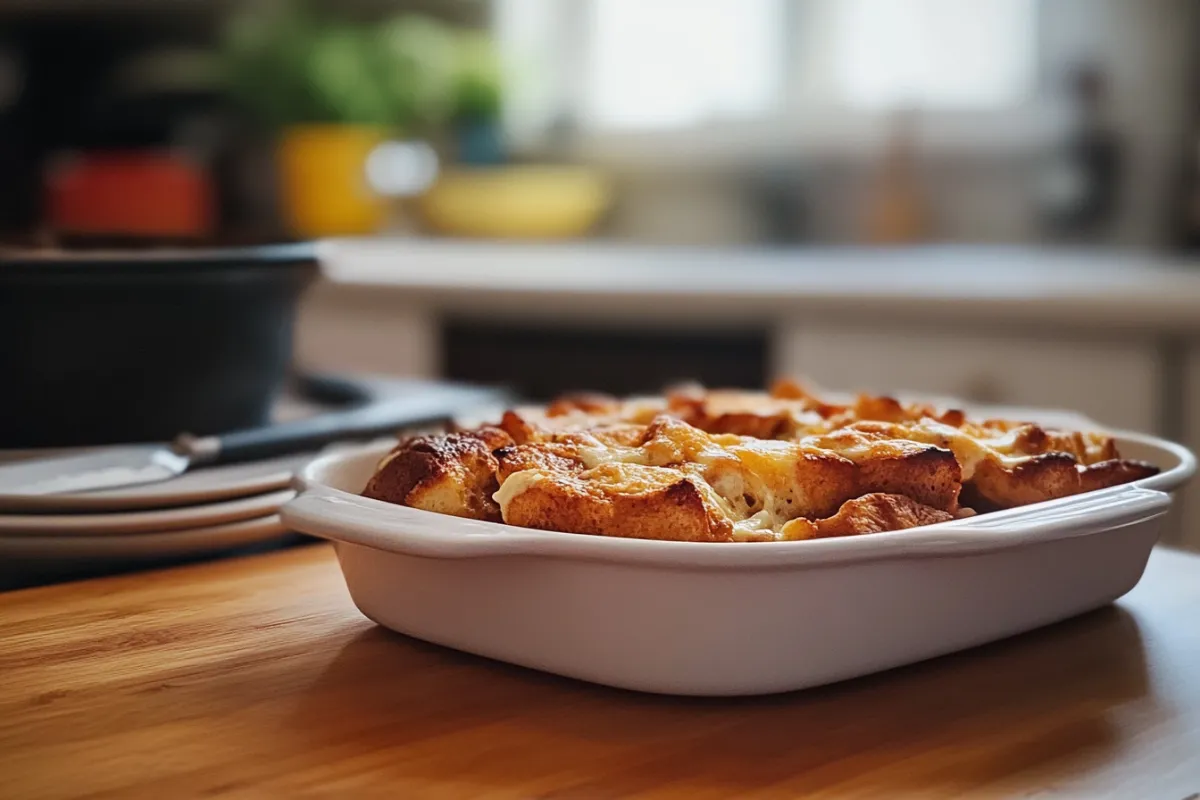Table of Content
- Introduction
- The Science Behind French Toast Casserole
- Reasons Your French Toast Casserole is Soggy
- How to Avoid a Soggy French Toast Casserol
- How to Fix Soggy French Toast Casserole
- Popular Variations of French Toast Casserole
- FAQs
- Conclusion
Introduction
“Why is my French toast casserole soggy?” is a frustrating question many home cooks find themselves asking after eagerly pulling their breakfast dish out of the oven. French toast casserole is supposed to be rich, indulgent, and slightly custardy on the inside with a golden, crisp exterior. However, achieving that perfect balance can be tricky, and when things go wrong, sogginess is usually the culprit.
Soggy French toast casserole can happen for several reasons—too much liquid, the wrong kind of bread, undercooking, or an improper egg-to-milk ratio. But don’t worry! This comprehensive guide will help you understand what causes soggy casseroles and provide practical solutions to ensure you never have to face this issue again. By the end, you’ll be confident in preparing a perfect French toast casserole that’s golden, flavorful, and just the right texture.
The Science Behind French Toast Casserole
To solve the problem of a soggy French toast casserole, it’s important to understand the science behind how this delicious dish works. French toast casserole, like traditional French toast, is all about creating a custard. Custard is a mixture of eggs and milk (or cream), which sets when it’s baked.
In a French toast casserole, bread acts as a sponge that soaks up the custard mixture. During the baking process, the heat cooks the custard, turning it from a liquid into a solidified, creamy texture. Ideally, the bread soaks up just enough custard to give the interior of the casserole a soft, melt-in-your-mouth feel, while the top gets crispy and golden.
Achieving this balance depends on several factors—most importantly, the ratio of liquid to bread, the type of bread you use, and how long you bake the casserole. Any imbalance in these factors can lead to either a too-dry casserole or, worse, one that’s soggy.

Reasons Your French Toast Casserole is Soggy
If your French toast casserole has turned out soggy, it’s likely due to one or more of the following common issues:
1. Too Much Liquid
The most common reason for a soggy French toast casserole is too much liquid in the recipe. The bread can only absorb so much custard, and when there’s an excess, the bread becomes overly saturated. Instead of turning soft and custard-like, it stays wet and soggy.
For optimal results, the amount of liquid should be in proportion to the amount of bread. A good starting point is using about 1 cup of milk for every 4 cups of bread cubes. Additionally, each cup of liquid should include about 2 eggs, which help the custard set properly. Without enough eggs, the liquid won’t bind well, leading to a wet texture.
2. Incorrect Bread Choice
Choosing the wrong kind of bread can make or break your French toast casserole. Soft breads like white sandwich bread, brioche, or challah are delicious but have a tendency to soak up too much liquid, leading to a soggy casserole.
For best results, use a sturdier, more resilient bread like:
- French bread
- Sourdough
- Challah (slightly stale)
- Baguette
It’s also best to use day-old or slightly stale bread. Fresh bread has too much moisture, which can combine with the custard mixture and result in a mushy texture. Using drier bread allows it to absorb the custard without breaking down.
3. Insufficient Cooking Time
Another frequent issue is underbaking the casserole. When the custard hasn’t had enough time to fully cook and set, the center of your casserole can remain soggy. Even if the top appears golden and crispy, the middle can still be undercooked and mushy.
Baking times vary depending on the depth of your dish and the amount of liquid used, but typically, a French toast casserole should bake at 350°F (175°C) for at least 45-60 minutes. Always check the casserole’s center with a toothpick or knife to ensure it has fully set before removing it from the oven.
4. Uneven Soaking or Over-Soaking the Bread
Soaking the bread evenly is crucial for a consistent texture throughout your casserole. Some recipes suggest soaking the bread for a short period before baking, while others recommend an overnight soak to maximize flavor absorption.
However, if the bread soaks for too long, it may become overly saturated and lose its structure, turning your casserole into a soggy mess. On the flip side, not soaking the bread enough can result in uneven textures, with some pieces staying dry while others are overly moist. To avoid this, make sure each bread piece is evenly coated in custard and soaked for the right amount of time—typically 10-15 minutes for immediate baking or overnight for refrigerated versions.
5. Improper Egg-to-Dairy Ratio
The proper ratio of eggs to milk or cream is crucial for getting the right custard consistency. If you use too much dairy and not enough eggs, the mixture will be too liquidy, and it won’t firm up during baking. Conversely, too many eggs can make the casserole too firm and dry.
A typical ratio for French toast casserole is 2 eggs for every 1 cup of milk. This gives a custard mixture that will set nicely but still have that soft, rich texture you’re aiming for.

How to Avoid a Soggy French Toast Casserole
Now that we’ve covered the reasons your French toast casserole might turn out soggy, let’s explore some effective ways to prevent it from happening in the future.
1. Choose the Right Bread
As mentioned earlier, the type of bread you use plays a crucial role in achieving the perfect texture. Here’s what to keep in mind:
- Go for sturdy, thick breads like French bread, sourdough, or challah.
- Day-old bread is preferable. If your bread is fresh, leave it out for a few hours to dry it slightly, or you can lightly toast it in the oven to remove excess moisture.
These types of bread won’t break down as easily when soaked in custard, ensuring that the final texture is soft but not mushy.
2. Follow the Right Egg-to-Milk Ratio
One of the most critical aspects of making a French toast casserole is getting the custard ratio right. You want enough eggs to help the mixture set without it becoming too firm. The general guideline of 2 eggs per 1 cup of milk or cream works well for most recipes. For a large casserole, you might use around 6-8 eggs and 3-4 cups of milk.
3. Prep the Bread
If your bread is too soft or fresh, it’s more likely to become soggy when soaked in the custard. Here’s how you can avoid that:
- Dry out your bread by leaving it uncovered on the counter for a few hours.
- Toast the bread lightly in the oven before adding the custard to remove some of the moisture.
This step helps the bread hold its shape better and absorb the custard without falling apart.
4. Bake at the Right Temperature
Temperature is key to ensuring your casserole bakes evenly and thoroughly. For most French toast casseroles, 350°F (175°C) is the optimal temperature. Cooking it too quickly at a higher temperature can cause the edges to burn before the center has time to set. On the other hand, baking at too low of a temperature may leave the center undercooked and soggy.
5. Use a Proper Baking Dish
The type and size of your baking dish can influence how well your casserole bakes. A shallow, even baking dish works best for even cooking. If your dish is too deep, the custard mixture may not bake evenly, resulting in a soggy center.
How to Fix Soggy French Toast Casserole
If you’ve already baked your casserole and it’s soggy, don’t despair—there are a few things you can do to salvage it:
1. Extend the Baking Time
If the center of your casserole is still wet after the recommended baking time, simply extend the time by 5-10 minutes. Check for doneness by inserting a knife or toothpick into the center. If it comes out clean or with only a few crumbs, the casserole is done.
2. Use the Broiler to Crisp the Top
If the inside of your casserole is cooked but the top is soggy, you can use your oven’s broiler to crisp it up. Turn the broiler on high and place the casserole under it for 2-3 minutes. Keep a close eye on it, as the top can go from golden to burnt quickly.
3. Let the Casserole Sit Before Serving
Allowing the casserole to rest for 10-15 minutes after baking can help firm up the interior. This cooling period gives the custard time to set fully and results in a better texture.
4. Reheating Soggy Leftovers
If you’ve refrigerated leftovers and they seem a bit soggy, don’t fret. Reheat the casserole in the oven at 350°F for 10-15 minutes. The heat will help dry out excess moisture, and your casserole will be warm and crispy again.

Popular Variations of French Toast Casserole
There are countless ways to customize French toast casserole, making it a versatile dish for any occasion. Here are a few popular variations:
1. Stuffed French Toast Casserole
For a more indulgent version, try stuffing your casserole with a filling like cream cheese, Nutella, or fruit preserves. To do this, layer half of the bread, spread the filling, and then cover with the remaining bread before pouring the custard over.
2. Overnight French Toast Casserole
An overnight version of French toast casserole allows the bread to soak up the custard fully, resulting in a richer flavor. Simply assemble the casserole the night before, cover it, and refrigerate it overnight. The next morning, pop it in the oven and bake as usual.
3. Savory French Toast Casserole
For a savory twist, replace the sugar and cinnamon with herbs, cheese, and vegetables. Ingredients like sautéed spinach, mushrooms, and shredded cheddar work well. You can also add cooked turkey sausage or chicken for a heartier dish.
FAQs
Can You Make French Toast Casserole in Advance?
Yes! You can prepare French toast casserole in advance and store it in the refrigerator for up to 24 hours before baking. This method is perfect for brunches or holiday breakfasts when you want to save time. Just be sure to cover it tightly with plastic wrap and refrigerate it until you’re ready to bake.
Can You Freeze French Toast Casserole?
Yes, French toast casserole freezes well. To freeze, bake the casserole first, then allow it to cool completely. Wrap it tightly in plastic wrap and aluminum foil before freezing. It can be frozen for up to 2 months. When you’re ready to enjoy it, thaw in the refrigerator overnight and reheat in the oven at 350°F for 15-20 minutes until warmed through.
What Can I Do If My Casserole Is Dry?
If your casserole turns out too dry, you can easily fix it by drizzling a bit of warm syrup or a splash of milk over the top before serving. This will add moisture without making the dish soggy. You can also serve it with fresh fruit or whipped cream for added texture and flavor.
Conclusion
A soggy French toast casserole doesn’t have to ruin your breakfast. By understanding the common causes—like too much liquid, the wrong bread, or undercooking—you can avoid this issue and perfect your French toast casserole every time. Choose sturdy bread, use the correct egg-to-milk ratio, and bake it at the right temperature. If you do end up with a soggy casserole, extending the baking time or using the broiler can help rescue it.
With these tips, your next French toast casserole will be perfectly crisp on the outside, custardy on the inside, and sure to impress at any breakfast or brunch gathering.

